The temperatures will be challenging for Saturday’s Heart Run and Walk. Starting at a mere -5 degrees F (can you say "Brrrrr!") and rising to a whopping 30 degrees (a heat wave!). Since I know we run slower in the cold, just as in extreme heat, I wondered HOW MUCH slower. Here is the information found on LIVESTRONG.
Overall Effects
Both heat and cold can affect your running times, with a temperature of 50 degrees Fahrenheit being optimal, Coach Tom Schwarz states. The lower the temperature, the greater the effect. According to a formula Schwarz devised, you can expect a time increase of 1.66 percent when the temperature drops to 30, a 3 percent increase at 20, a 5.33 percent increase at 10 degree Fahrenheit and an 8.33 percent increase in time when the temperature hits zero.
Running Conditions
Running conditions in cold weather can also affect your speed. Running on ice or snow will slow you down; wearing shoes with studs can help to improve traction and help you keep your speed up. Running into a cold wind can also affect your speed, and hypothermia can affect your coordination, which will certainly impact your overall running time.
Precautions
Take precautions to keep from developing hypothermia when you run in the cold. Although it’s a myth that you lose a huge percentage of your body heat through the top of your head, you do lose some, so wear a hat. A hat or scarf that covers your nose and mouth warms the air before you breathe it. Layer your clothing rather than wearing one heavy layer, which can slow you down. Layering also keeps you warmer by trapping warm air between the layers. Avoid cotton, which doesn’t dry easily. Materials that breathe, such as Gore-Tex, are both lightweight and warm.
Considerations
You can run even when it’s cold, but you’ll run more comfortably, safely and probably faster when you take precautions. Warming up your muscles to avoid injury before starting off on a run is even more essential when the temperature drops. If you develop signs of hypothermia, such as slowed thinking, decreased coordination or sluggish speech, it’s time to go back inside and warm up until the weather does.
It doesn’t matter what the weather brings Saturday morning, runners will be on the roads. We only hope there is no wind and the temperatures climb to at least in the teens by the start of the first run….can only hope.
Slow Cook Salmon with Chickpeas and Greens (another BonAppetit based recipe).
Serves 4
- 2 TBS olive oil – more if necessary
- 15 oz can of chickpeas, rinse and drain
- 1/2 tsp ground cumin
- salt, about 1/4 tsp
- ground pepper, about 1/2 tsp.
- 1 tsp minced garlic
- 1 bunch Collards: washed and boiled for 15 minutes, drained and dried.
- 1 tsp honey
- 3 to 4 6 oz skinless salmon fillets
- 1/4 cup chopped onion
- 2 TBS lemon juice
- 1 tsp Dijon
- salt and pepper to taste
- 3 TBS olive oil
- 1 1/2 TBS capers, rinsed and dried.
Preheat the oven 250 F.
Pour 2 TBS olive oil in baking dish.
Combine the chickpeas with cumin, salt, pepper and mash half with a fork. Transfer to baking dish.
Heat 2 TBS oil in large skillet (or the large, high sided pan you may have used to cook the greens). Cook garlic about 30 seconds then add greens and cook about 1 minute. Add the honey mixed with 1/4 cup of water. Cook for 4 minutes, tossing to coat and cook evenly. Transfer to the chickpea mixture in baking dish.
Season salmon with salt and pepper and place on top of greens and chickpeas.
Mix the onion, lemon, Dijon, 1 TBS oil and capers (salt and pepper if needed but remember that you salted the salmon already). Pour the onion-lemon mix over the salmon.
Bake for 35 – 40 minutes.
Have you been exercising outside this winter?
What’s your “cold threshold limit” e.g. won’t go outside to walk/run/play with dogs if it’s below 5 degrees

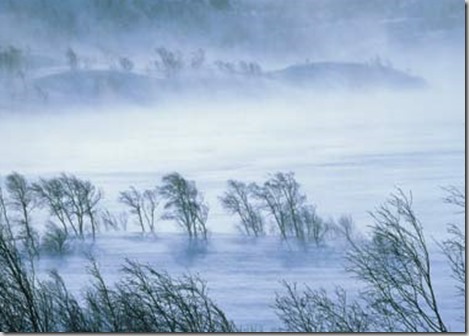
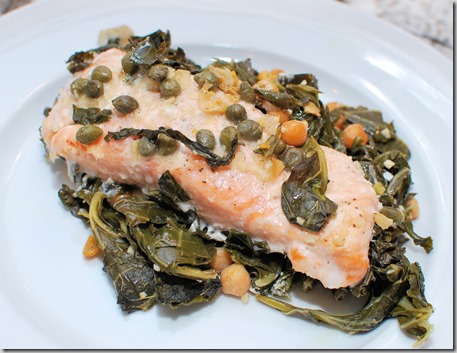
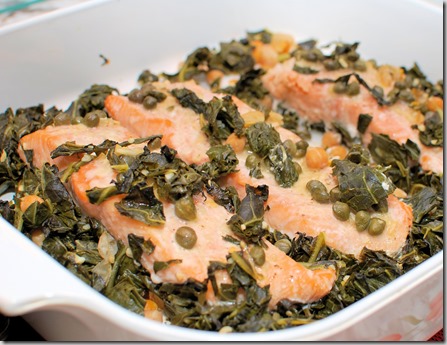
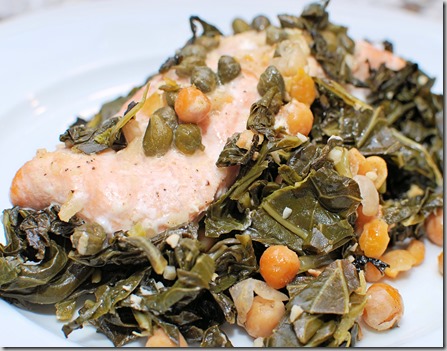

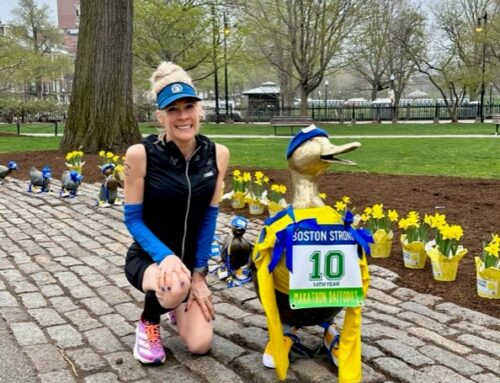
Stay safe, it sounds so cold but you have the determination!
Your salmon looks flavoured absolutely wonderfully 😀
Cheers
Choc Chip Uru